Information injection-pump assembly
BOSCH
9 400 619 790
9400619790
ZEXEL
108822-2030
1088222030
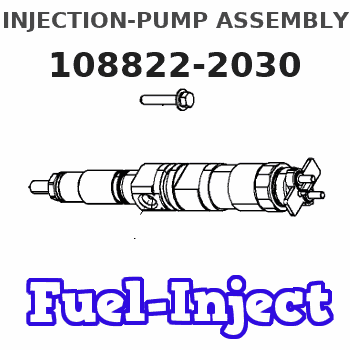
Rating:
Service parts 108822-2030 INJECTION-PUMP ASSEMBLY:
1.
_
5.
AUTOM. ADVANCE MECHANIS
7.
COUPLING PLATE
11.
Nozzle and Holder
12.
Open Pre:MPa(Kqf/cm2)
17.7{180}/21.6{220}
14.
NOZZLE
Include in #1:
108822-2030
as INJECTION-PUMP ASSEMBLY
Cross reference number
BOSCH
9 400 619 790
9400619790
ZEXEL
108822-2030
1088222030
Zexel num
Bosch num
Firm num
Name
Calibration Data:
Adjustment conditions
Test oil
1404 Test oil ISO4113 or {SAEJ967d}
1404 Test oil ISO4113 or {SAEJ967d}
Test oil temperature
degC
40
40
45
Nozzle and nozzle holder
105780-8230
Nozzle
105780-0110
Nozzle holder
105780-2170
Opening pressure
MPa
17.2
Opening pressure
kgf/cm2
175
Injection pipe
Outer diameter - inner diameter - length (mm) mm 8-3-600
Outer diameter - inner diameter - length (mm) mm 8-3-600
Overflow valve
131425-0220
Overflow valve opening pressure
kPa
157
123
191
Overflow valve opening pressure
kgf/cm2
1.6
1.25
1.95
Tester oil delivery pressure
kPa
255
255
255
Tester oil delivery pressure
kgf/cm2
2.6
2.6
2.6
PS/ACT control unit part no.
407980-2
24*
Digi switch no.
42
Direction of rotation (viewed from drive side)
Right R
Right R
Injection timing adjustment
Direction of rotation (viewed from drive side)
Right R
Right R
Injection order
1-2-7-3-
4-5-6-8
Pre-stroke
mm
8.5
8.47
8.53
Beginning of injection position
Governor side NO.1
Governor side NO.1
Difference between angles 1
Cyl.1-2 deg. 45 44.75 45.25
Cyl.1-2 deg. 45 44.75 45.25
Difference between angles 2
Cal 1-7 deg. 90 89.75 90.25
Cal 1-7 deg. 90 89.75 90.25
Difference between angles 3
Cal 1-3 deg. 135 134.75 135.25
Cal 1-3 deg. 135 134.75 135.25
Difference between angles 4
Cal 1-4 deg. 180 179.75 180.25
Cal 1-4 deg. 180 179.75 180.25
Difference between angles 5
Cal 1-5 deg. 225 224.75 225.25
Cal 1-5 deg. 225 224.75 225.25
Difference between angles 6
Cal 1-6 deg. 270 269.75 270.25
Cal 1-6 deg. 270 269.75 270.25
Difference between angles 7
Cal 1-8 deg. 315 314.75 315.25
Cal 1-8 deg. 315 314.75 315.25
Injection quantity adjustment
Adjusting point
-
Rack position
13.3
Pump speed
r/min
700
700
700
Average injection quantity
mm3/st.
127
125.4
128.6
Max. variation between cylinders
%
0
-3
3
Basic
*
Fixing the rack
*
PS407980-224*
V
2.45+-0.
01
PS407980-224*
mm
6.1+-0.0
5
Standard for adjustment of the maximum variation between cylinders
*
Injection quantity adjustment_02
Adjusting point
Z
Rack position
8.5+-0.5
Pump speed
r/min
290
290
290
Average injection quantity
mm3/st.
23.5
20.9
26.1
Max. variation between cylinders
%
0
-15
15
Fixing the rack
*
PS407980-224*
V
V1+0.05+
-0.01
PS407980-224*
mm
8.4+-0.0
3
Standard for adjustment of the maximum variation between cylinders
*
Remarks
Refer to items regarding the pre-stroke actuator
Refer to items regarding the pre-stroke actuator
Injection quantity adjustment_03
Adjusting point
A
Rack position
R1(13.3)
Pump speed
r/min
700
700
700
Average injection quantity
mm3/st.
127
126
128
Basic
*
Fixing the lever
*
PS407980-224*
V
2.45+-0.
01
PS407980-224*
mm
6.1+-0.0
5
Injection quantity adjustment_04
Adjusting point
B
Rack position
R1+1.55
Pump speed
r/min
1100
1100
1100
Average injection quantity
mm3/st.
129.5
125.5
133.5
Fixing the lever
*
PS407980-224*
V
2.45+-0.
01
PS407980-224*
mm
6.1+-0.0
5
0000001601
Pre-stroke
mm
8.5
8.47
8.53
Remarks
When the timing sleeve is pushed up
When the timing sleeve is pushed up
_02
Connector angle
deg.
8.5
8
9
Remarks
When the eccentric pin is tightened
When the eccentric pin is tightened
_03
Supply voltage
V
24
23.5
24.5
Ambient temperature
degC
23
18
28
Pre-stroke
mm
6.1
6.05
6.15
Output voltage
V
2.45
2.44
2.46
Adjustment
*
_04
Supply voltage
V
24
23.5
24.5
Ambient temperature
degC
23
18
28
Pre-stroke
mm
8.5
8.47
8.53
Output voltage
V
1.2
1
1.4
Confirmation
*
Remarks
Output voltage V1
Output voltage V1
_05
Supply voltage
V
24
23.5
24.5
Ambient temperature
degC
23
18
28
Pre-stroke
mm
5.5
Output voltage
V
3
2.98
3
Confirmation
*
_06
Supply voltage
V
24
23.5
24.5
Ambient temperature
degC
23
18
28
Output voltage
V
3.05
3.05
Confirmation of operating range
*
Test data Ex:
Governor adjustment
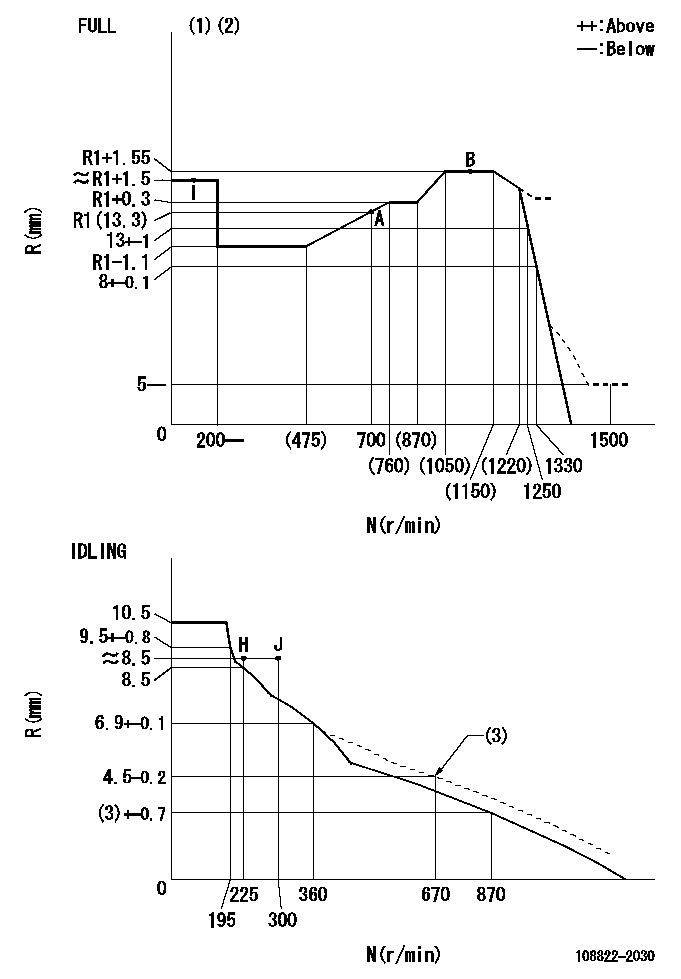
N:Pump speed
R:Rack position (mm)
(1)Torque cam stamping: T1
(2)Tolerance for racks not indicated: +-0.05mm.
(3)Damper spring setting
----------
T1=AB07
----------
----------
T1=AB07
----------
Speed control lever angle
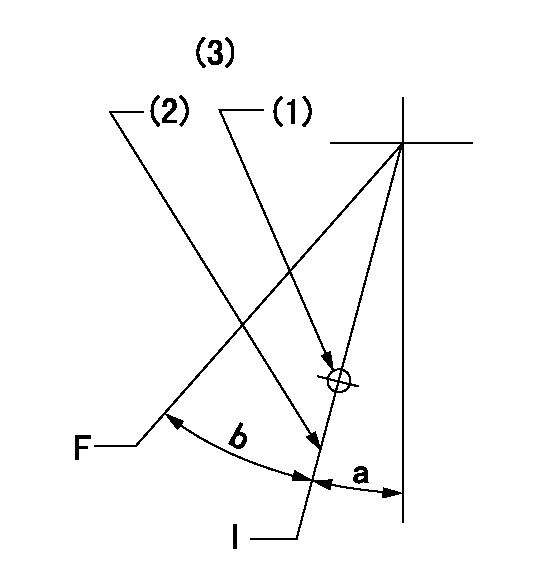
F:Full speed
I:Idle
(1)Use the hole at R = aa
(2)Stopper bolt set position 'H'
(3)Viewed from feed pump side.
----------
aa=37.5mm
----------
a=30deg+-5deg b=(40deg)+-3deg
----------
aa=37.5mm
----------
a=30deg+-5deg b=(40deg)+-3deg
Stop lever angle

N:Pump normal
S:Stop the pump.
(1)Use the hole at R = aa
(2)Set the stopper bolt so that speed = bb and rack position = cc. (Confirm non-injection.)
(3)Normal engine position (equivalent to R = dd).
----------
aa=31.5mm bb=1100r/min cc=3.5+-0.3mm dd=18mm
----------
a=(31deg)+-5deg b=11.5deg+-5deg c=41deg+-5deg
----------
aa=31.5mm bb=1100r/min cc=3.5+-0.3mm dd=18mm
----------
a=(31deg)+-5deg b=11.5deg+-5deg c=41deg+-5deg
0000001301
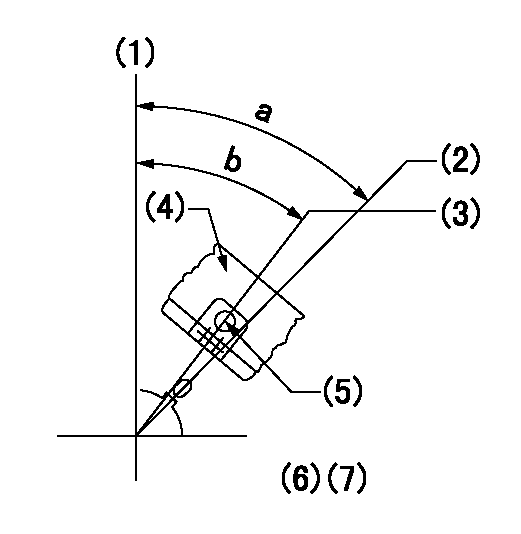
(1)Pump vertical direction
(2)Coupling's key groove position at No 1 cylinder's beginning of injection
(3)At the No 1 cylinder's beginning of injection position, stamp an aligning mark on the damper to align with the pointer's groove.
(4)Damper
(5)Pointer
(6)B.T.D.C.: aa
(7)Pre-stroke: bb
----------
aa=4deg bb=8.5+-0.03mm
----------
a=(45deg) b=(44deg)
----------
aa=4deg bb=8.5+-0.03mm
----------
a=(45deg) b=(44deg)
0000001901
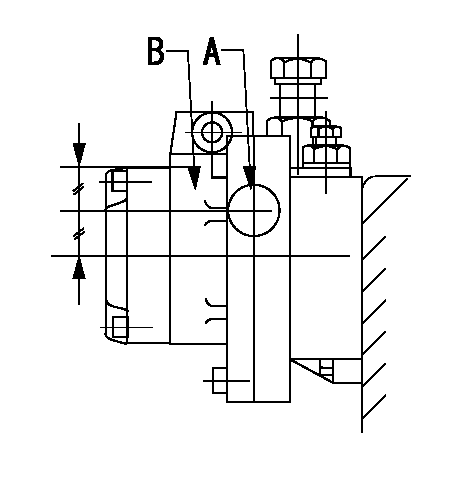
A:Sealing position
B:Pre-stroke actuator
1. When installing the pre-stroke actuator on the pump, first tighten the installation bolts loosely, then move the actuator fully counterclockwise (viewed from the drive side).
Temporary tightening torque: 1 - 1.5 N.m (0.1 - 0.15 kgf.m)
2. Move the actuator in the clockwise direction when viewed from the drive side, and adjust so that it becomes the adjustment point of the adjustment value. Then tighten it.
Tightening torque: 7^9 N.m (0.7^0.9 kgf.m)
3. After prestroke actuator installation adjustment, simultaneously stamp both the actuator side and housing side.
----------
----------
----------
----------
0000002201 MICRO SWITCH
Adjustment of the micro-switch
Adjust the bolt to obtain the following lever position when the micro-switch is ON.
(1)Speed N1
(2)Rack position Ra
----------
N1=325r/min Ra=8.5+-0.1mm
----------
----------
N1=325r/min Ra=8.5+-0.1mm
----------
0000002301 RACK SENSOR
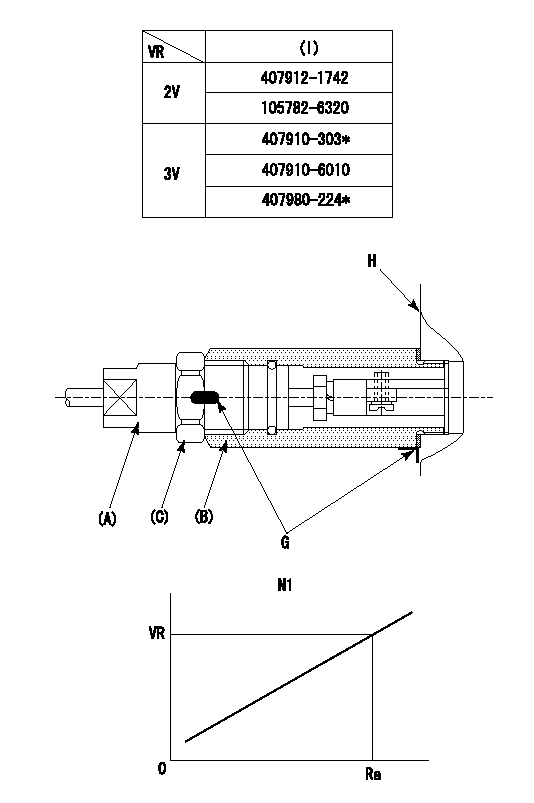
(VR) measurement voltage
(I) Part number of the control unit
(G) Apply red paint.
(H): End surface of the pump
1. Rack sensor adjustment (-0620)
(1)Fix the speed control lever at the full position
(2)Set the speed to N1 r/min.
(If the boost compensator is provided, apply boost pressure.)
(3)Adjust the bobbin (A) so that the rack sensor's output voltage is VR+-0.01.
(4)At that time, rack position must be Ra.
(5)Apply G at two places.
Connecting part between the joint (B) and the nut (F)
Connecting part between the joint (B) and the end surface of the pump (H)
----------
N1=1100r/min Ra=R1(13.3)+1.55mm
----------
----------
N1=1100r/min Ra=R1(13.3)+1.55mm
----------
Information:
Warning Operation
Two flashing warning lamps and an alarm inform the operator that: * An ether cylinder is empty.* Both ether cylinders are empty.* A noncritical fault is present.* A critical fault is present.The warning lamps and alarm can be tested by placing the ether system switch in the Test/Disable position. The warning alarm will turn ON for two seconds and the warning lamps will remain ON continuously until the switch is returned to the Auto position. If a solenoid valve is shorted to +BAT, the alarm sounds whenever the key switch is in the RUN or START position. The alarm beeps at the rate of approximately 1.3 seconds ON and 2.0 seconds OFF. The engine could be damaged if ether was injected before the engine is cranked.An Ether Cylinder Is Empty
One of the two warning lamps inform the operator when an ether cylinder is empty. The lamp flashes at the rate of 1.5 Hz (flashes per second) with equal ON and OFF times. The lamps and ether solenoid assemblies are correspondingly marked 1 and 2. When empty ether cylinder warning lamp 1 is flashing, ether cylinder 1 needs replaced. When empty ether cylinder warning lamp 2 is flashing, ether cylinder 2 needs replaced. (On 3516 engines, both ether cylinders of the set need replaced.) The lamps stop flashing when the reset switch is activated during ether cylinder replacement. The empty ether cylinder warning lamp will also flash if there is no ether cylinder installed.Both Ether Cylinders Are Empty
When both ether cylinders are empty (on 3516 engines, both ether cylinder sets), both empty ether cylinder warning lamps and the alarm are activated. Empty ether cylinder warning lamps 1 and 2 flash at the same time, at the rate of 1.5 Hz (flashes per second). The alarm also sounds, during the ether injection time, approximately 1.3 seconds ON and 2.0 seconds OFF.A Noncritical Fault Is Present
When a noncritical fault is present, both empty ether cylinder warning lamps are activated. Empty ether cylinder warning lamps 1 and 2 flash alternately (taking turns ON and OFF) at the rate of 3.0 Hz (flashes per second). The system continues to operate during a noncritical fault.A Critical Fault Is Present
When a critical fault is present. both empty ether cylinder warning lamps and the alarm are activated. Empty ether cylinder warning lamps 1 and 2 flash alternately (taking turns ON and OFF) at the rate of 3.0 Hz (flashes per second). The alarm also sounds, during the ether injection time, approximately 1.3 seconds ON and 2.0 seconds OFF. If possible, ether injections are disabled during a critical fault.Diagnostic Operation
Ether Injection Control DiagnosticsThe ether injection control has diagnostic capabilities to assist in troubleshooting. The control detects and records faults that occur to the system. During a critical fault, if possible, the control disables ether injection. During a noncritical fault, the control takes alternate action so that the system continues to function.The diagnostic display, on the ether injection control, displays a code which represents the fault that
Two flashing warning lamps and an alarm inform the operator that: * An ether cylinder is empty.* Both ether cylinders are empty.* A noncritical fault is present.* A critical fault is present.The warning lamps and alarm can be tested by placing the ether system switch in the Test/Disable position. The warning alarm will turn ON for two seconds and the warning lamps will remain ON continuously until the switch is returned to the Auto position. If a solenoid valve is shorted to +BAT, the alarm sounds whenever the key switch is in the RUN or START position. The alarm beeps at the rate of approximately 1.3 seconds ON and 2.0 seconds OFF. The engine could be damaged if ether was injected before the engine is cranked.An Ether Cylinder Is Empty
One of the two warning lamps inform the operator when an ether cylinder is empty. The lamp flashes at the rate of 1.5 Hz (flashes per second) with equal ON and OFF times. The lamps and ether solenoid assemblies are correspondingly marked 1 and 2. When empty ether cylinder warning lamp 1 is flashing, ether cylinder 1 needs replaced. When empty ether cylinder warning lamp 2 is flashing, ether cylinder 2 needs replaced. (On 3516 engines, both ether cylinders of the set need replaced.) The lamps stop flashing when the reset switch is activated during ether cylinder replacement. The empty ether cylinder warning lamp will also flash if there is no ether cylinder installed.Both Ether Cylinders Are Empty
When both ether cylinders are empty (on 3516 engines, both ether cylinder sets), both empty ether cylinder warning lamps and the alarm are activated. Empty ether cylinder warning lamps 1 and 2 flash at the same time, at the rate of 1.5 Hz (flashes per second). The alarm also sounds, during the ether injection time, approximately 1.3 seconds ON and 2.0 seconds OFF.A Noncritical Fault Is Present
When a noncritical fault is present, both empty ether cylinder warning lamps are activated. Empty ether cylinder warning lamps 1 and 2 flash alternately (taking turns ON and OFF) at the rate of 3.0 Hz (flashes per second). The system continues to operate during a noncritical fault.A Critical Fault Is Present
When a critical fault is present. both empty ether cylinder warning lamps and the alarm are activated. Empty ether cylinder warning lamps 1 and 2 flash alternately (taking turns ON and OFF) at the rate of 3.0 Hz (flashes per second). The alarm also sounds, during the ether injection time, approximately 1.3 seconds ON and 2.0 seconds OFF. If possible, ether injections are disabled during a critical fault.Diagnostic Operation
Ether Injection Control DiagnosticsThe ether injection control has diagnostic capabilities to assist in troubleshooting. The control detects and records faults that occur to the system. During a critical fault, if possible, the control disables ether injection. During a noncritical fault, the control takes alternate action so that the system continues to function.The diagnostic display, on the ether injection control, displays a code which represents the fault that